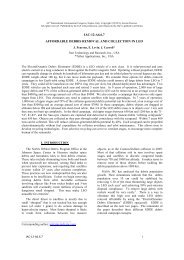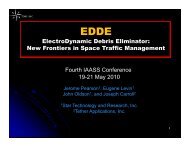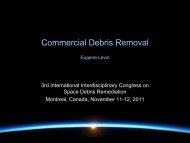The Cost of Future Collisions in LEO - Star Technology and Research
The Cost of Future Collisions in LEO - Star Technology and Research
The Cost of Future Collisions in LEO - Star Technology and Research
Create successful ePaper yourself
Turn your PDF publications into a flip-book with our unique Google optimized e-Paper software.
8<br />
are synthesized from the probability-weighted <strong>and</strong> time-averaged streams from all<br />
possible catastrophic collisions. However, we can treat them as physical streams<br />
for the purpose <strong>of</strong> statistical damage calculations.<br />
We will now focus on a very narrow range <strong>of</strong> fragment masses around 1 g<br />
that are believed to be at the “threshold <strong>of</strong> lethality” <strong>in</strong> terms <strong>of</strong> the impacts on<br />
the operational satellites. For short-term projections <strong>in</strong> this range, we will separate<br />
mass <strong>and</strong> altitude distributions by sett<strong>in</strong>g<br />
We will also use cumulative distributions<br />
<strong>and</strong><br />
ρ ki (m, H) = f ki (m) g ki (H). (7)<br />
F ki (m) =<br />
G ki (H) =<br />
∫ ∞<br />
m<br />
∫ ∞<br />
H<br />
f ki (µ) dµ (8)<br />
g ki (h) dh. (9)<br />
Appendix B suggests a simple power law distribution for the number <strong>of</strong> fragments<br />
heavier than m,<br />
F ki (m) = κ ki M k (m c /m) γ , (10)<br />
where m c = 1 g is a characteristic mass, κ ki is the average statistically expected<br />
yield <strong>of</strong> fragments heavier than m c per unit mass <strong>of</strong> the object B k produced <strong>in</strong><br />
a collision with the object B i , M k is the mass <strong>of</strong> the object B k , <strong>and</strong> γ ≈ 0.8.<br />
Based on the data from the Fengyun-1C <strong>and</strong> Cosmos-Iridium events, an estimate<br />
<strong>of</strong> κ ki ≈ 24/kg is derived <strong>in</strong> Appendix B. For each object, the average yield will<br />
depend on its composition <strong>and</strong> design. <strong>The</strong> correspond<strong>in</strong>g distribution density is<br />
f ki (m) = κ ki M k γ m γ c /m γ+1 . (11)<br />
Analysis <strong>in</strong> Appendix C suggests the follow<strong>in</strong>g approximation for the altitude<br />
distribution <strong>of</strong> collision fragments<br />
n(h, h 0 ) = k 0<br />
h s<br />
(<br />
1 + |h − h 0|<br />
h s<br />
) −b<br />
, (12)<br />
where h 0 is the collision altitude, h s is the scale height <strong>of</strong> the distribution, b ≈ 2.37,<br />
<strong>and</strong> k 0 = (b − 1)/2 ≈ 0.69 is a normalization coefficient, such that<br />
∫ ∞<br />
0<br />
n(h, h 0 ) dh = 1.<br />
Characteristic values <strong>of</strong> h s are estimated <strong>in</strong> Appendix C for tracked collision fragments,<br />
however, there is no data on small untracked fragments. It is anticipated








